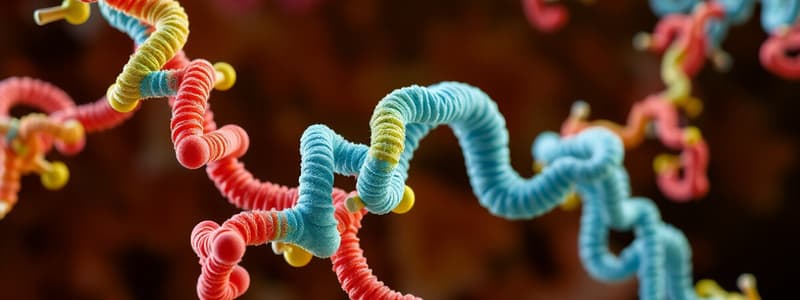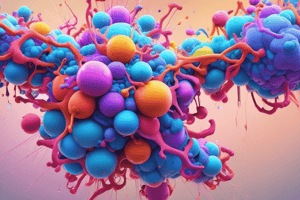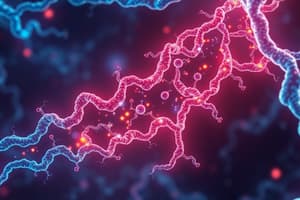Podcast
Questions and Answers
What is the primary role of receptor proteins in cells?
What is the primary role of receptor proteins in cells?
- To receive external signals and induce intracellular responses (correct)
- To store energy for future use
- To transport molecules across the cell membrane
- To break down glucose for metabolism
What is the effect of an agonist on a receptor protein?
What is the effect of an agonist on a receptor protein?
- It permanently binds to the receptor and alters its structure.
- It serves as a signaling molecule without binding.
- It binds to the receptor and induces a biological response. (correct)
- It blocks the receptor's activity and prevents responses.
How does the binding strength of an agonist to its receptor influence cellular response?
How does the binding strength of an agonist to its receptor influence cellular response?
- A stronger binding requires less agonist for a significant response. (correct)
- A lower binding strength always leads to a higher cellular response.
- Weakly binding agonists enhance receptor activity.
- All agonists produce identical responses regardless of binding strength.
What is the characteristic of ligands called antagonists?
What is the characteristic of ligands called antagonists?
Which of the following describes a necessary condition for receptor protein activity?
Which of the following describes a necessary condition for receptor protein activity?
What does a high Kd value imply about an agonist's binding to its receptor?
What does a high Kd value imply about an agonist's binding to its receptor?
Which of the following factors can influence receptor protein activity?
Which of the following factors can influence receptor protein activity?
What type of response is primarily induced by chemical signals acting through receptor proteins?
What type of response is primarily induced by chemical signals acting through receptor proteins?
In low-glucose conditions, how do cells typically respond?
In low-glucose conditions, how do cells typically respond?
What does the G protein bind in its inactive form?
What does the G protein bind in its inactive form?
What occurs when an agonist binds to a GPCR?
What occurs when an agonist binds to a GPCR?
Which subunit of the G protein is responsible for interacting with enzymes when activated?
Which subunit of the G protein is responsible for interacting with enzymes when activated?
What is the primary effect of insulin binding to its receptor on liver cells?
What is the primary effect of insulin binding to its receptor on liver cells?
What is one of the most common effects of activated G proteins?
What is one of the most common effects of activated G proteins?
What happens to phosphoenolpyruvate carboxykinase (PEPCK) when insulin binds to its receptor?
What happens to phosphoenolpyruvate carboxykinase (PEPCK) when insulin binds to its receptor?
What is the result of the signal amplification phenomenon?
What is the result of the signal amplification phenomenon?
What does the α subunit do to revert to its inactive form?
What does the α subunit do to revert to its inactive form?
How do hydrophobic signal molecules typically interact with target cells?
How do hydrophobic signal molecules typically interact with target cells?
What type of proteins do GPCRs primarily interact with?
What type of proteins do GPCRs primarily interact with?
What is the role of cytosolic receptors after binding to hydrophobic signals?
What is the role of cytosolic receptors after binding to hydrophobic signals?
What effect does cortisol have compared to insulin in metabolism?
What effect does cortisol have compared to insulin in metabolism?
Which pathway is often triggered by GPCR signaling?
Which pathway is often triggered by GPCR signaling?
What is the primary role of cyclic AMP in cellular signaling?
What is the primary role of cyclic AMP in cellular signaling?
Why do hydrophobic molecules require carrier proteins for transport in the bloodstream?
Why do hydrophobic molecules require carrier proteins for transport in the bloodstream?
What is a characteristic of G proteins?
What is a characteristic of G proteins?
What is a key difference in response speed between cytosolic receptors and signal cascades?
What is a key difference in response speed between cytosolic receptors and signal cascades?
What role does phosphofructokinase-2 play in glucose metabolism?
What role does phosphofructokinase-2 play in glucose metabolism?
Which of the following statements is true about the metabolic effects of insulin and cortisol?
Which of the following statements is true about the metabolic effects of insulin and cortisol?
What is the main way hydrophobic signals differ from other signaling methods?
What is the main way hydrophobic signals differ from other signaling methods?
What is the main difference in the effect of an agonist compared to an antagonist when binding to a receptor?
What is the main difference in the effect of an agonist compared to an antagonist when binding to a receptor?
How do antagonists generally interact with agonists at the receptor site?
How do antagonists generally interact with agonists at the receptor site?
What is an allosteric antagonist known to do?
What is an allosteric antagonist known to do?
What type of molecules primarily interact with transmembrane receptor proteins?
What type of molecules primarily interact with transmembrane receptor proteins?
What occurs at the intracellular domain of a transmembrane receptor after an agonist binds the extracellular domain?
What occurs at the intracellular domain of a transmembrane receptor after an agonist binds the extracellular domain?
What is the result of secondary messenger activation due to agonist binding?
What is the result of secondary messenger activation due to agonist binding?
What mechanism allows an agonist to counteract an antagonist?
What mechanism allows an agonist to counteract an antagonist?
What characterizes the binding of an allosteric antagonist compared to a competitive antagonist?
What characterizes the binding of an allosteric antagonist compared to a competitive antagonist?
Which statement accurately describes the role of secondary messengers?
Which statement accurately describes the role of secondary messengers?
In what situation would an increase in the concentration of an agonist not reverse the effects of an allosteric antagonist?
In what situation would an increase in the concentration of an agonist not reverse the effects of an allosteric antagonist?
Flashcards
Receptor Protein
Receptor Protein
A protein that receives an extracellular signal and triggers a specific response within the cell.
Ligand
Ligand
A molecule that binds to a receptor protein and initiates a biological response.
Agonist
Agonist
A ligand that binds to a receptor and triggers the intended biological response.
Kd (Dissociation Constant)
Kd (Dissociation Constant)
Signup and view all the flashcards
Antagonist
Antagonist
Signup and view all the flashcards
Cellular Responsiveness
Cellular Responsiveness
Signup and view all the flashcards
Active Transport
Active Transport
Signup and view all the flashcards
Energy Management
Energy Management
Signup and view all the flashcards
Glucose Breakdown
Glucose Breakdown
Signup and view all the flashcards
Glucose Storage
Glucose Storage
Signup and view all the flashcards
G Protein-Coupled Receptor (GPCR)
G Protein-Coupled Receptor (GPCR)
Signup and view all the flashcards
G Protein
G Protein
Signup and view all the flashcards
Conformational Change
Conformational Change
Signup and view all the flashcards
GTP Hydrolysis
GTP Hydrolysis
Signup and view all the flashcards
Adenylyl Cyclase
Adenylyl Cyclase
Signup and view all the flashcards
Signal Cascade
Signal Cascade
Signup and view all the flashcards
Phosphorylation
Phosphorylation
Signup and view all the flashcards
Primary Binding Site
Primary Binding Site
Signup and view all the flashcards
Allosteric Site
Allosteric Site
Signup and view all the flashcards
Competitive Antagonist
Competitive Antagonist
Signup and view all the flashcards
Allosteric Antagonist
Allosteric Antagonist
Signup and view all the flashcards
Transmembrane Receptor
Transmembrane Receptor
Signup and view all the flashcards
Second Messenger
Second Messenger
Signup and view all the flashcards
Extracellular Domain
Extracellular Domain
Signup and view all the flashcards
Intracellular Domain
Intracellular Domain
Signup and view all the flashcards
Affinity
Affinity
Signup and view all the flashcards
Cytosolic Signaling
Cytosolic Signaling
Signup and view all the flashcards
Hydrophobic Agonist
Hydrophobic Agonist
Signup and view all the flashcards
Cytosolic Receptor
Cytosolic Receptor
Signup and view all the flashcards
Nuclear Transport
Nuclear Transport
Signup and view all the flashcards
Transcription Factor
Transcription Factor
Signup and view all the flashcards
Agonist Activation
Agonist Activation
Signup and view all the flashcards
Dissociation Constant (Kd)
Dissociation Constant (Kd)
Signup and view all the flashcards
Extracellular Signal
Extracellular Signal
Signup and view all the flashcards
Study Notes
Protein Activity and Receptors
- Proteins constantly adapt to cellular conditions, like responding to high glucose levels by storing or breaking down glucose for energy.
- Receptor proteins receive extracellular signals (chemicals, light, electrical impulses, pressure) to trigger intracellular responses.
- Ligands are chemical signals that bind to receptors, causing a response.
- Agonists are ligands that bind receptors and induce primary responses; they have specific binding to their particular receptor. Similar molecules might also bind and induce responses.
- Agonist binding strength is measured by Kd (dissociation constant); a low Kd indicates strong binding, allowing a significant response with lower agonist concentrations. Conversely, a high Kd indicates weak binding and requires higher agonist concentrations for a significant response.
- Antagonists impede agonist binding; they don't elicit the same biological response of the agonist. Antagonists can bind at the same or different sites as agonists, either competing for the binding site or interfering with the agonist's ability to transmit a signal or reduce the affinity between the receptor and agonist.
- Allosteric antagonist binding can hinder agonist binding but not completely block it. They might reduce the receptor's affinity for the agonist or change the intensity of the response.
Transmembrane Receptors
- Hydrophilic signals can't pass through the cell membrane directly.
- Transmembrane receptors receive them; the extracellular domain binds the signal, triggering a conformational change in the intracellular domain.
- This change alters interactions with other molecules within the cell, triggering a response.
G Protein-Coupled Receptors (GPCRs)
- GPCRs are a crucial class of transmembrane receptors.
- They have seven transmembrane regions and interact with G proteins, which are protein complexes that mediate intracellular signaling.
- In an inactive state, the G protein binds GDP; agonist binding changes the receptor, causing GDP to switch to GTP, activating the G protein.
- The activated G protein subunits then interact with other enzymes (like adenylyl cyclase in the case of cAMP production), influencing downstream events and triggering cellular responses (e.g., changes in gene expression).
Signal Cascades
- Signal cascades can amplify initial signals, leading to a larger cellular response via a series of protein phosphorylations.
- A single agonist binding can lead to the phosphorylation of numerous proteins.
- This process is called signal amplification.
Hydrophobic Signals and Cytosolic Receptors
- Hydrophobic signals readily cross the cell membrane.
- They interact with cytosolic receptors, and the resulting receptor-ligand complex then enters the nucleus.
- In the nucleus, the complex acts as a transcription factor affecting gene expression (e.g., regulates glucose production).
Studying That Suits You
Use AI to generate personalized quizzes and flashcards to suit your learning preferences.




